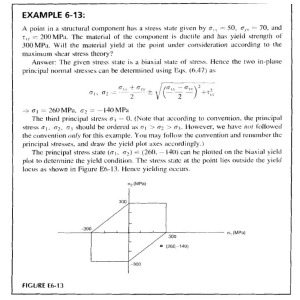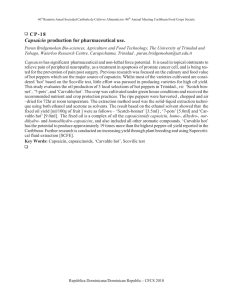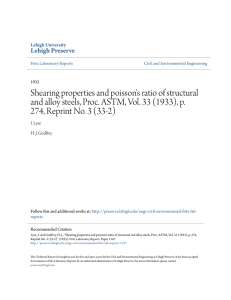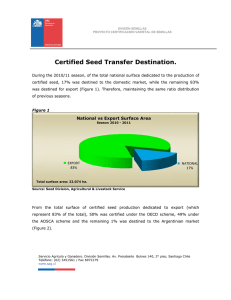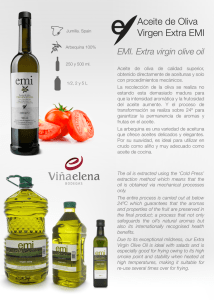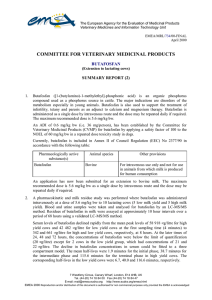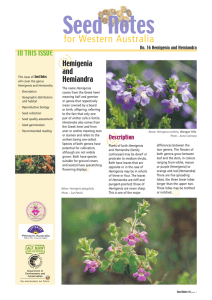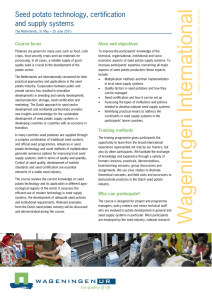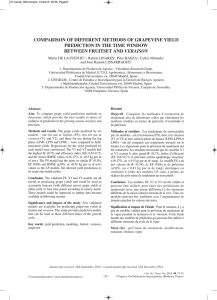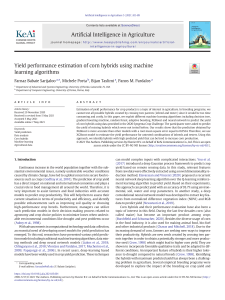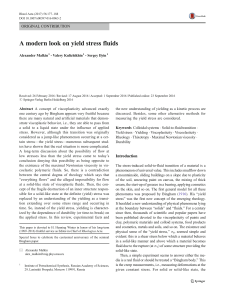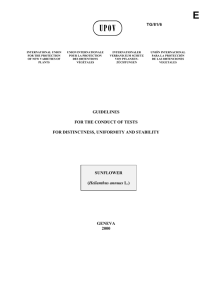population improvement for seed yield and oil content
Anuncio
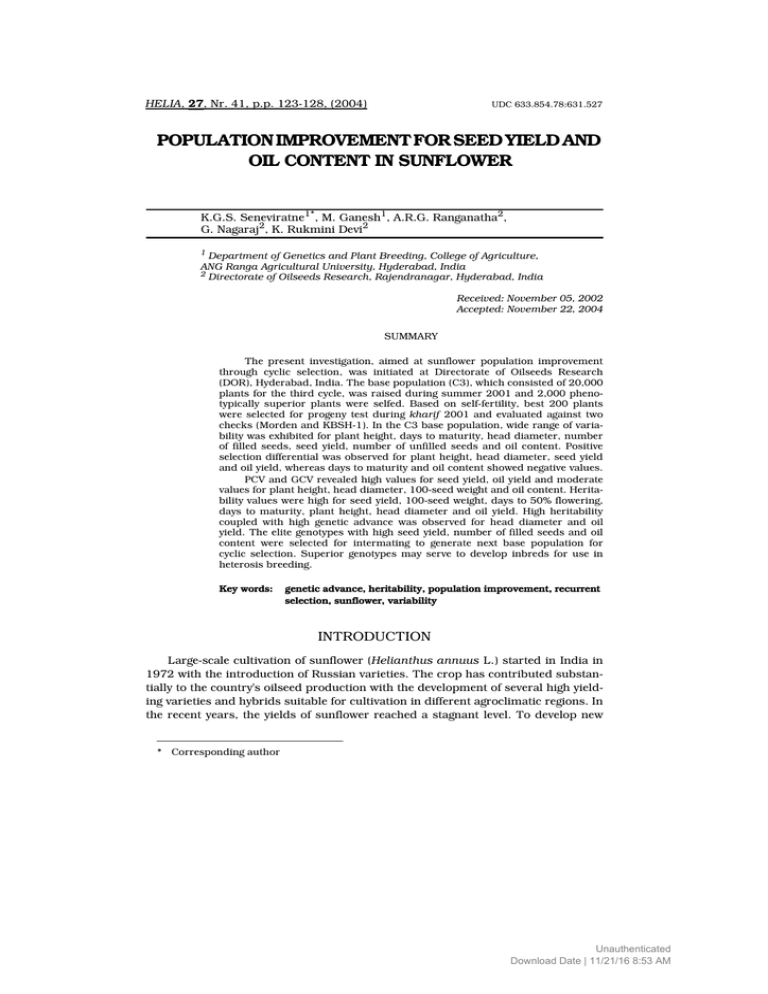
HELIA, 27, Nr. 41, p.p. 123-128, (2004) UDC 633.854.78:631.527 POPULATION IMPROVEMENT FOR SEED YIELD AND OIL CONTENT IN SUNFLOWER K.G.S. Seneviratne1*, M. Ganesh1, A.R.G. Ranganatha2, G. Nagaraj2, K. Rukmini Devi2 1 Department of Genetics and Plant Breeding, College of Agriculture, ANG Ranga Agricultural University, Hyderabad, India 2 Directorate of Oilseeds Research, Rajendranagar, Hyderabad, India Received: November 05, 2002 Accepted: November 22, 2004 SUMMARY The present investigation, aimed at sunflower population improvement through cyclic selection, was initiated at Directorate of Oilseeds Research (DOR), Hyderabad, India. The base population (C3), which consisted of 20,000 plants for the third cycle, was raised during summer 2001 and 2,000 phenotypically superior plants were selfed. Based on self-fertility, best 200 plants were selected for progeny test during kharif 2001 and evaluated against two checks (Morden and KBSH-1). In the C3 base population, wide range of variability was exhibited for plant height, days to maturity, head diameter, number of filled seeds, seed yield, number of unfilled seeds and oil content. Positive selection differential was observed for plant height, head diameter, seed yield and oil yield, whereas days to maturity and oil content showed negative values. PCV and GCV revealed high values for seed yield, oil yield and moderate values for plant height, head diameter, 100-seed weight and oil content. Heritability values were high for seed yield, 100-seed weight, days to 50% flowering, days to maturity, plant height, head diameter and oil yield. High heritability coupled with high genetic advance was observed for head diameter and oil yield. The elite genotypes with high seed yield, number of filled seeds and oil content were selected for intermating to generate next base population for cyclic selection. Superior genotypes may serve to develop inbreds for use in heterosis breeding. Key words: genetic advance, heritability, population improvement, recurrent selection, sunflower, variability INTRODUCTION Large-scale cultivation of sunflower (Helianthus annuus L.) started in India in 1972 with the introduction of Russian varieties. The crop has contributed substantially to the country's oilseed production with the development of several high yielding varieties and hybrids suitable for cultivation in different agroclimatic regions. In the recent years, the yields of sunflower reached a stagnant level. To develop new * Corresponding author Unauthenticated Download Date | 11/21/16 8:53 AM 124 HELIA, 27, Nr. 41, p.p. 123-128, (2004) superior inbreds, good inbreds are needed. The development of superior inbreds from population involves several selection programs. Systematic population improvement program helps the breeder to generate superior populations with improved performance by directional selection followed by intermating of the reselects. This gives impetus for the development of elite inbred lines. Further, it enables the development of superior hybrids, synthetics and composites. Also, these inbreds act as a potential genetic resource. Miller et al. (1977) obtained an increment of 12.2% of oil content after 3 cycles of simple recurrent selection. Miller and Hammand (1985) reported an increase in seed yield by 6.3% after 3 cycles of selection. The present study was undertaken to improve the base population by adopting simple recurrent selection with a progeny testing for yield and yield attributes of sunflower. MATERIALS AND METHODS The present study aimed at the improvement of the sunflower population in the third cycle (C3) started at Directorate of Oilseeds Research, Hyderabad, India in summer 2001. Using seeds of second selection cycle (C2) a population of about 20,000 plants were grown in bulk and about 2,000 plants were selected and selfed. Out of these 2,000 individuals, 200 best performing plants were selected for progeny test based on high autogamy, high oil content, high number of filled seeds and high seed yield. The progeny test was performed during kharif 2001. The selected plants were evaluated against two checks (Morden and KBSH-1) in randomized block design, replicated twice. Observations were recorded for plant height, days to 50% flowering, days to maturity, head diameter, 100-seed weight, oil content, seed yield and oil yield. The mean performance of the 2,000 individuals and mean, range, variance, phenotypic coefficient of variation (PCV), genotypic coefficient of variation (GCV), heritability in broad sense, genetic advance, genetic advance as percent of mean and selection differential for 202 progenies were worked out. RESULTS AND DISCUSSION The genotypes in the third base population exhibited considerable variation for seed yield and yield-contributing characters (Table 1). Table 1: Variability parameters of the third cycle base population (C3) in sunflower Character Mean Range Days to maturity 92.7 84-105 Plant height (cm) 145.53 82-200 Head diameter (cm) 11.14 6-21 373 0-1545 Number of unfilled seeds per plant 120 0-1427 Unfilled seed weight per plant (g) 1.78 0-15.4 Seed yield per plant (g) 15.11 0-61.8 Oil content (%) 32.47 19.82-44.30 Number of filled seeds per plant Unauthenticated Download Date | 11/21/16 8:53 AM HELIA, 27, Nr. 41, p.p. 123-128, (2004) 125 Plant height ranged from 82 cm to as much as 200 cm, head diameter from as low as 6 cm to as high as 21 cm, seed yield per plant from zero to very high (61.8 g), unfilled seed weight from zero to 15.4 g, number of filled seeds per plant from zero to as high as 1,545 seeds, number of unfilled seeds from zero to as high as 1427, days to maturity from 84 days to 105 days and oil content from 19.82% to 44.3%. The selection imposed has narrowed down the variability of plant height, days to maturity, head diameter, seed yield, oil content and oil yield. Positive selection differential values were observed for plant height (4.66 cm), head diameter (2.55 cm), seed yield per plant (3.7 g) and oil yield per plant (0.41 g), whereas, days to maturity (-8.2 days) in desirable direction and oil content (-0.48%) showed negative values (Table 2). Table 2: Range, mean and selection differential for seed yield and its attributes in sunflower Character Range Mean Selection differential P 82-200 145.53 4.66 S1 99.33-195.67 150.19 Plant height (cm) Head diameter (cm) P 6-21 11.14 S1 9.67-19.33 13.69 P 84-105 92.70 S1 76-97 84.50 Days to maturity Seed yield/plant (g) P 0-61.8 15.11 S1 8.03-33.74 18.81 P 19.82-44.3 32.47 S1 18.96-40.48 31.99 P 0-11.25 5.63 S1 1.6-13.32 6.04 Oil content (%) Oil yield/plant (g) 2.55 -8.2 3.7 -0.48 0.41 P=population of the third cycle; S1=progenies of the selected plants Virupakshappa and Sindagi (1987) and Salera and Detti (1990) observed high range of variation for plant height, 100-seed weight, seed yield and oil content. Teklewold et al. (1999) recorded high range of values for number of filled seeds, percent autogamy, seed yield per plant and percent seed set. Table 3: Genetic variability parameters for seed yield and its attributes in 202 lines of sunflower Character Mean Coefficient of variation (%) Phenotypic Genotypic Heritability (%) Genetic Genetic advance (Broad sense) advance as % of mean Days to 50% flowering 54.95 6.26 5.53 78.25 4.73 Days to maturity 84.95 4.03 3.60 79.94 4.81 8.61 5.66 Plant height (cm) 150.19 10.20 10.00 96.12 25.92 17.26 Head diameter (cm) 13.69 13.02 12.43 91.23 2.86 20.89 100-seed weight (g) 4.33 15.85 13.08 68.18 0.82 18.94 Seed yield/plant (g) 18.81 27.84 24.05 74.59 6.87 3.65 Oil content (%) 31.99 10.52 10.17 93.48 5.54 17.32 Oil yield/plant (g) 6.04 30.87 27.23 77.81 2.55 42.22 Unauthenticated Download Date | 11/21/16 8:53 AM 126 HELIA, 27, Nr. 41, p.p. 123-128, (2004) The values of PCV and GCV were high for seed yield and oil yield per plant (Table 3). These findings were in accordance with the findings by Teklewold et al. (1999). Plant height, head diameter, 100-seed weight and oil content showed moderate PCV and GCV values. Moderate PCV and GCV values were reported for oil content by Teklewold et al. (1999). Among the characters, days to 50% flowering and days to maturity exhibited low PCV and GCV values. These results were in harmony with the results of Teklewold et al. (1999) and Ashok et al. (2000). The heritability estimates indicate the expressivity of trait with which a genotype can be assessed by its phenotype and its effective utilization in judging the phenotypic selection. High heritability (h2b) estimates were observed for plant height, days to 50% flowering, head diameter, days to maturity, 100-seed weight, oil content, seed yield per plant and oil yield (Table 3). Similar results were also reported by Teklewold et al. (1999), Ashok et al. (2000) and Khan (2001). Heritability values alone cannot provide any indication of the amount of progress that would result from selection because heritability in broad sense includes both additive and non-additive gene action. Therefore, high heritability estimates in broad sense would be a reliable tool for selection if accompanied by high genetic advance as percent of mean. High heritability associated with high genetic advance as percent of mean were recorded for head diameter and oil yield per plant indicating lesser environmental influence on these characters and a role of additive gene action. Similar observations for head diameter and oil yield were also reported by Teklewold et al. (1999) and Ashok et al. (2000). High heritability estimates associated with moderate genetic advance as percent of mean was recorded for plant height, 100-seed weight and oil content suggesting that these characters were less influenced by environment but governed by both additive and non-additive gene action. These findings were in true agreement with the results obtained by Muhammad et al. (1992). High heritability estimates associated with low genetic advance recorded for days to 50% flowering, days to maturity and seed yield showed that these characters are influenced by the environment due to its non-additive gene action. CONCLUSION Enormous variability was detected in the studied sunflower population. This made the cyclic selection more effective and recorded substantial amount of genetic gain for the traits. The elite genotypes with high seed yield, number of filled seeds and oil content can be utilized to develop superior inbred lines for the development of superior synthetics and hybrids. Hence, population improvement program is essential to any crop improvement. It will give a new gene pool, which is useful to practicing breeders. Unauthenticated Download Date | 11/21/16 8:53 AM HELIA, 27, Nr. 41, p.p. 123-128, (2004) 127 REFERENCES Ashok, S., Narayanan, S.L., and Kumaresan, D., 2000. Variability studies for yield and its components. Journal of Oilseeds Research 17(2): 239-241. Khan, A., 2001. Yield performance heritability and interrelationship in some quantitative traits in sunflower. Helia 24(34): 35-40. Miller, J.F., Fick, G.N. and Cedeno, J.R., 1977. Improvement of oil content and quality in sunflower. Agronomy Abstracts, pp. 64. Miller, J.F. and Hammond, J.J., 1985 Improvement of yield in sunflower utilizing reciprocal full-sib selection. Proceedings of the 11th Sunflower Conference, Mar del Plata, Argentina, pp. 715-717. Muhammad, Tariq, Idrees, G. and Tahir, A., 1992, Genetic variability and correlation studies in sunflower. Sarhad Journal of Agriculture 8(6): 659-663. Salera, E. and Detti, G.M., 1990. Adaptation and yield potential of sunflower (Helianthus annuus L.). Floral Agriculture, 46: 53-57. Teklewold, A., Jayaramaiah, H. and Ramesh, S., 1999. Genetic variability studies in sunflower. Crop Improvement 26(2): 236-240. Virupakshappa, K. and Sindagi, S.S., 1987. Characterization, evaluation and utilization of sunflower germplasm accessions, a catalogue. Unit of the Project Coordinator (Sunflower), GKVK, Bangalore. MEJORAMIENTO DE LA POBLACIÓN PARA EL RENDIMIENTO DE SEMILLA Y CONTENIDO DEL ACEITE EN GIRASOL RESUMEN Esta investigación, emprendida con el fin de mejoramiento de las poblaciones mediante selección cíclica de girasol, se realizó en la Dirección de Investigaciones de los Cultivos Oleaginosos en Hyderabad, La India. La población básica (C3), que constaba de 20.000 plantas del tercer ciclo, se cultivaba a lo largo del verano de 2001, y 2000 plantas superiores desde el punto de vista de fenotipo, fueron autofecundadas. Doscientas plantas mejores fueron elegidas sobre la base de aptitud para la autofecundación para la prueba de descendencia, realizada durante la campana 'karif' de 2001, con dos variedades de control (Morden y KBSH-1). La población básica C3 demostró gran variabilidad en la altura de la planta, el número de días hasta la madurez, el diámetro del capitulo, el número de las semillas sobrevertidas, el rendimiento de la semilla, el número de las semillas no sobrevertidas y el contenido de aceite. La diferencia positiva de selección, obtenida para la altura de la planta, el diámetro del capítulo, el rendimiento de semilla y el rendimiento de aceite. Los valores negativos se obtuvieron en el número de días hasta la madurez y el contenido de aceite. Los coeficientes fenotípicos y genotípicos de la variación, han demostrado los altos valores para el rendimiento de semilla y el rendimiento de aceite, y los valores medios para la altura de la planta, el diámetro del capítulo, el peso de 100 semillas y el contenido de aceite. Los valores de heritabilidad eran altos en el rendimiento de semilla, el peso de 100 semillas, el número de días hasta 50% de floración, el número de días hasta la madurez, la altura de la planta, el diámetro del capítulo y el rendimiento de aceite. Alta heritabilidad, relacionada con el alto avance genético, fue observada en el diámetro del capítulo y el rendimiento de aceite. Los mejores genotipos con alto rendimiento de semilla, el número de semillas sobrevertidas y el contenido de aceite, fueron elegidos para el cruzamiento, para que se formara la siguiente población básica para la selección cíclica. Los genotipos con valores acrecentados pueden servir para la formación de las líneas consanguíneas (inbred) que pueden utilizarse en la selección de híbridos. Unauthenticated Download Date | 11/21/16 8:53 AM 128 HELIA, 27, Nr. 41, p.p. 123-128, (2004) AMÉLIORATION DE LA POPULATION POUR LE RENDEMENT DES SEMENCES ET DU CONTENU D’HUILE DANS LE TOURNESOL RÉSUMÉ Cette recherche, destinée à l’amélioration de la population par une sélection cyclique a été entreprise à la Direction de la recherche sur les cultures oléagineuses, Hyderabad, Inde. La population de base (C3) qui était constituée de 20 000 plantes du troisième cycle, a été cultivée durant l’été 2001 et 2000 phénotypes de plantes supérieures ont été autofécondées. Les 200 meilleures plantes ont été sélectionnées d’après un test de la descendance avec deux sortes contrôle (Morden et KBSH-1) pendant la saison de kharif 2001. Dans la population de base C3, une grande échelle de variabilité s’est manifestée pour ce qui est de la hauteur de la plante, la durée de maturation, le diamètre de la tête, le nombre de graines pleines, le rendement des graines, le nombre de graines vides et le contenu d’huile. Une différence de sélection positive a été observée pour ce qui concerne la hauteur de la plante, le diamètre de la tête, le rendement des graines et le rendement d’huile alors que la durée nécessaire à la maturation et le contenu d’huile avaient des valeurs négatives. Les coefficients de variance phénotypiques et génotypiques ont manifesté des valeurs élevées pour le rendement des graines et le rendement d’huile, des valeurs moyennes pour la hauteur de la plante, le diamètre de la tête, le poids de 100 graines et le contenu d’huile. Les valeurs de transmission étaient élevées pour le rendement des graines, le poids de 100 graines, le nombre de jours avant 50% de la floraison, le nombre de jours avant la maturité, la hauteur de la plante, le diamètre de la tête et le rendement d’huile. Une grande transmission associée à un progrès génétique élevé a été observée pour le diamètre de la tête et le rendement d’huile. Les meilleurs génotypes ayant un rendement d’huile et un nombre de graines pleines importants ont été sélectionnés pour le croisement dans le but de générer la prochaine population de base pour la sélection cyclique. Les génotypes supérieurs peuvent servir à développer des lignées pour la sélection d’hybrides. Unauthenticated Download Date | 11/21/16 8:53 AM
